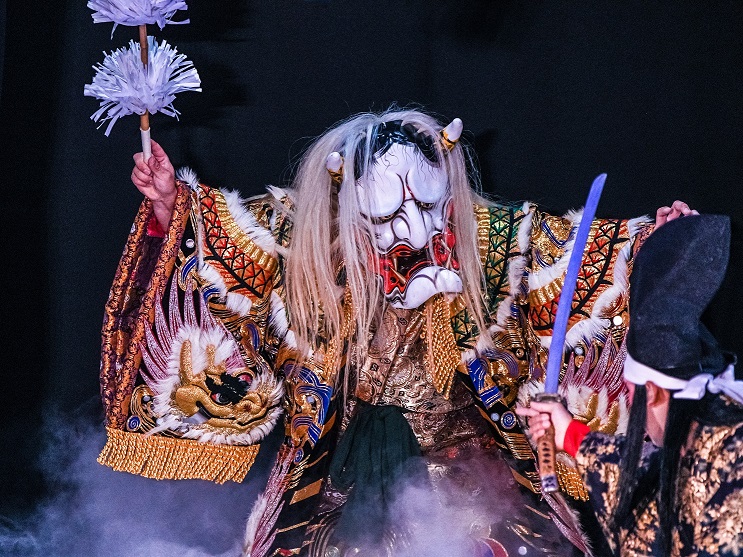The Haunting Beauty of Hannya Masks
Within the hallowed halls of Japanese theatre, where stories are told through the subtle language of movement, Hannya masks emerge as silent spectres, their carved features whispering tales of passion, vengeance, and the eternal dance between beauty and monstrosity. As we peel back the layers of these enigmatic masks, we unveil not just the essence of Noh and Kabuki traditions but also a deeper understanding of the intricate artistry that defines Japan’s theatrical soul.

Theatrical Roots: Noh and Kabuki Traditions
In the heart of traditional Japanese theatre, the Hannya mask finds its ancestral home within the venerable traditions of Noh and Kabuki. Noh, with its minimalist approach, and Kabuki, the more extravagant and colourful sibling, both embrace the Hannya mask as a conduit for conveying intense emotions and portraying characters that transcend the human experience. Within the silence of Noh and the vibrant gestures of Kabuki, the Hannya mask becomes a canvas for exploring the complex tapestry of human emotion.
Symbolism Beyond the Surface
A first encounter with the Hannya mask might evoke a sense of trepidation—sharp fangs, demonic eyes, and an expression twisted in anguish. Yet, beneath this seemingly grotesque exterior lies a rich tapestry of symbolism. The Hannya, with its deeply carved features, represents the transformation of a woman, often a spurned lover or jilted wife, into a vengeful and tormented entity. The mask becomes a visual allegory for the depth of human emotions and the haunting beauty that can reside within perceived monstrosity.
Craftsmanship of Hannya Masks
To truly appreciate the Hannya mask is to delve into the realm of master craftsmanship. Carved from blocks of Japanese cypress or other select woods, the process demands meticulous precision. The artisan navigates the delicate balance between capturing the mask’s symbolic essence and maintaining the integrity of its form. Once carved, the masks are adorned with a palette of colours, with shades of red, black, and white bringing the Hannya’s character to life.
Noh: The Sublime Dance of Emotion
In the contemplative world of Noh theatre, the Hannya mask takes centre stage as a silent narrator of profound emotional states. In plays like “Dojoji,” the Hannya embodies a vengeful spirit seeking retribution. The Noh performer, masked and clad in elaborate costumes, engages in a dance that transcends the physical. Every movement, every gesture, carries the weight of centuries of tradition, conveying a narrative that goes beyond the spoken word.
Kabuki: The Dynamic Expression of Hannya’s Wrath
Kabuki, known for its dynamic performances and vibrant aesthetics, elevates the emotional intensity of the Hannya mask to new heights. In plays like “Hannya Tabakoi,” actors don the mask to portray characters undergoing profound metamorphoses. The exaggerated makeup, elaborate costumes, and theatrical gestures amplify the Hannya’s wrath, creating a visual spectacle that resonates with the audience. Kabuki breathes life into the Hannya, transforming it from a static symbol into a dynamic force on the stage.
Beyond the Stage: Contemporary Significance
While rooted in ancient traditions, the Hannya mask extends its influence beyond the theatrical stage, seeping into contemporary Japanese culture. Its haunting visage becomes a symbol employed in various art forms, from traditional paintings to modern tattoos. The Hannya’s image is often invoked not just for its supernatural allure but also as a representation of the intricate interplay between beauty and the monstrous in the human experience.
The Dance of Dualities: Beauty and Monstrosity
The allure of the Hannya mask lies in its ability to embody dualities. Beyond the fearsome exterior lies a haunting beauty, and within the demonic expression, one can discern echoes of human struggles and passions. The mask serves as a poignant reminder that within perceived monstrosity, there exists a profound beauty—an artistic paradox that resonates through the ages.
Conclusion
In the silent drama of Noh and the vibrant theatrics of Kabuki, the Hannya mask stands as a silent narrator, whispering tales of love, betrayal, and the eternal dance between the beautiful and the monstrous. Its presence on the theatrical stage and beyond reflects the timeless allure of Japanese traditional arts, where emotions are carved, painted, and expressed in the eloquent silence of a wooden mask—an enduring symbol of the cultural richness that defines the soul of Japan. In the haunting beauty of Hannya masks, we find not only the essence of Japan’s theatrical traditions but also a reflection of the profound complexities that define the human experience.










